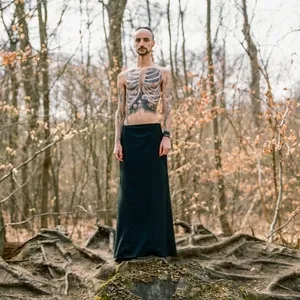
Body Sound Machine
Sound and music are inescapably connected with the body. Instruments and musical techniques shape the bodies of musicians and performers; acoustic vibrations shake the bodies of listeners; the body itself generates sounds by the simple act of being alive. And yet, the current trajectory of technological development, compulsively creating generative black boxes that mimic human creativity, is creating a rupture between sound and embodiment. The rupture extends to the relation between technology and the body. The idea of creating intelligent machines without bodies is flawed, for intelligence and creativity emerge from the relations between different bodies, people, traditions or radical rethinking thereof. There exist artists whose work not only mend the link of machines to embodiment, but reinvent it anew. They use many kinds of technology, building their own or subverting off-the-shelves tools. This is in fact a most fruitful way to reimagine relations between sounds and code, circuits and flesh, computers and bodies: radical subversion nurtured by curious artistic visions. Some of the most outstanding artists pursuing this approach today are collected in this playlist. The collection offers an insight into practices that blend sound, movement, instrument building, performance and even soil and spores. Notwithstanding fundamentally different practices, all the artists share a central concern with the human body, its forms and qualities, its capacity for relation with other humans and non-humans, and its expressive potential. Technology and sound become then a means to probe, emphasize, envision, critique and reframe forms of knowledge and expression forming through the flesh. In an uncanny duet, Joanathan Reus and Jaap Blonk call and respond to one another in highly dynamic crescendos. Blonk’s real voice plays against—or with, within, without—an AI model of his very own voice. The model, performed by Reus, far from the perfectly-voiced AI avatars filling the market, seems to creatively “misbehave” as it collapses transients and fragments of vocalization into relentless sound forms. The result is a thrilling improvisation of visceral expression. Using commercial generative AI models, Tomomi Adachi created a series of musical instruments that seems, at first, utterly unplayable by a human being. But Adachi built those instruments in the real world and developed ad hoc techniques to play them. Needless to say, the performance is as brilliant as unconventional, demonstrating the creative power of non-anthropocentric approaches to music and instrument building. Thinking beyond the human is key to the piece by Margherita Pevere in collaboration with musician Ivan Penov. Pevere tenses, morphs and slides her body among the burned soil and spores of a forest devastated by fire, while Penov uses field recordings of the same forest to manifest a sonic undergrowth. What we witness is not despair, but a celebration of non-human stubbornness and resilience. The soil dies, yes, but will inevitably thrive again from the ashes of the forest. Resilience is a theme that returns in the work of ella hebendanz and pamela varela. Here is the resilience of the female body in the face of its historical colonization by male doctors, scientists, priests and anatomists. In an uncompromising piece, ella and pamela perform not only their bodies but the very same technologies that through the centuries have defined and determined women’s bodies as an object of the male (medical) gaze. It is a reappropriation of and a claim to power. In a different and equally compelling way, Sól Ey critiques technological “progress” too, but she links it to questions of care and interpersonal connections. Her take on interactive music is not about technology per se, but rather about nurturing compassion in the machine. In her piece, bodies and machines need relation in order to perform, they seek one another and reach for the audience too, choreographing sound forms in search of a connection. Seeking connections of symbiont, machines and the urban landscape, the artist group Fronte Vacuo created a walking, durational performance that, in a quest for posthuman empathy, roams the territories between cities engaging passersby with what is most often overlooked: the thriving life of non-human creatures co-inhabiting streets, gardens and neighborhoods. Margherita Pevere, Marco Donnarumma and Andrew Munn become otherworldly characters murmuring secret rituals. Closing the collection is my own work, Ex Silens, a ritual of sensory reconfiguration. I embody an alien creature that through an eerie choreography with AI-based sonic prostheses caresses spectators, inviting them to open their bodies to a kaleidoscopic world of sound that goes otherwise unnoticed. Intense waves of vibrations and light, bodily sounds from muscle and heartbeat are literally amplified within their bodies, opening a new dimension of listening.






